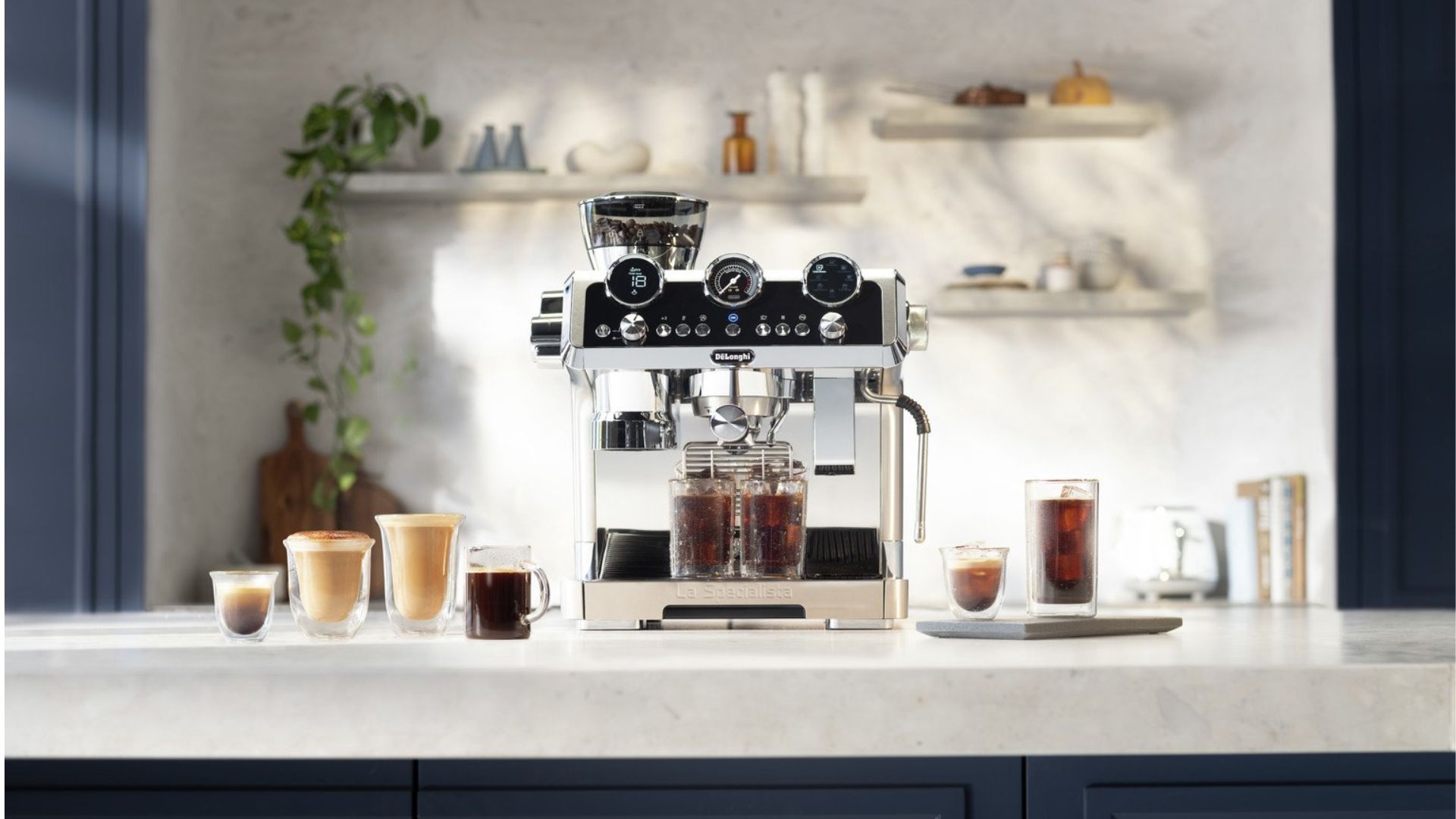
Dimensions: 14.48"L x 15"W x 17.5"H
Weight: 35.2 lb
Capacity: 67 fl oz
Pump pressure (bar): 19
Number of boilers: 2
Grind adjustment levels: 8
As a Homes Editor and kitchen expert, I've tried some of the best espresso makers on the market, but nothing so capable as the De'Longhi La Specialista Maestro. While they're rarely affordable, these luxury machines really are the best coffee makers available for coffee snobs like me who can't go a day without a good brew. But when summer hits, I often find that my espresso machine doesn't quite keep up with my love of iced coffee.
My carefully crafted espresso is quick to melt my ice, leading to a watery drink that doesn't pack the punch I like from iced coffee. In response to the rise of iced drinks as a go-to coffee preference, De'Longhi worked with the Specialty Coffee Association to design a system that can brew cold espresso or longer shots of cold brew in a matter of minutes. Consider me intrigued.
Cold brew aside, this is a capable dual-boiler coffee maker that can keep up the needs of a busy coffee-loving household. Its grinding process could use a bit more refinement and the automatic milk frother can be a bit fiddly, but for the price, this capable machine is a fantastic option.
De'Longhi La Specialista Maestro review: Price and availability
The De'Longhi La Specialista Maestro is not a cheap machine, although it can be found at a reduced price fairly often. The typical price (pre-discount) is $1,199 or £999. It's only available in one colorway, which is a sleek blend of black and stainless steel.
De'Longhi La Specialista Maestro review: Design
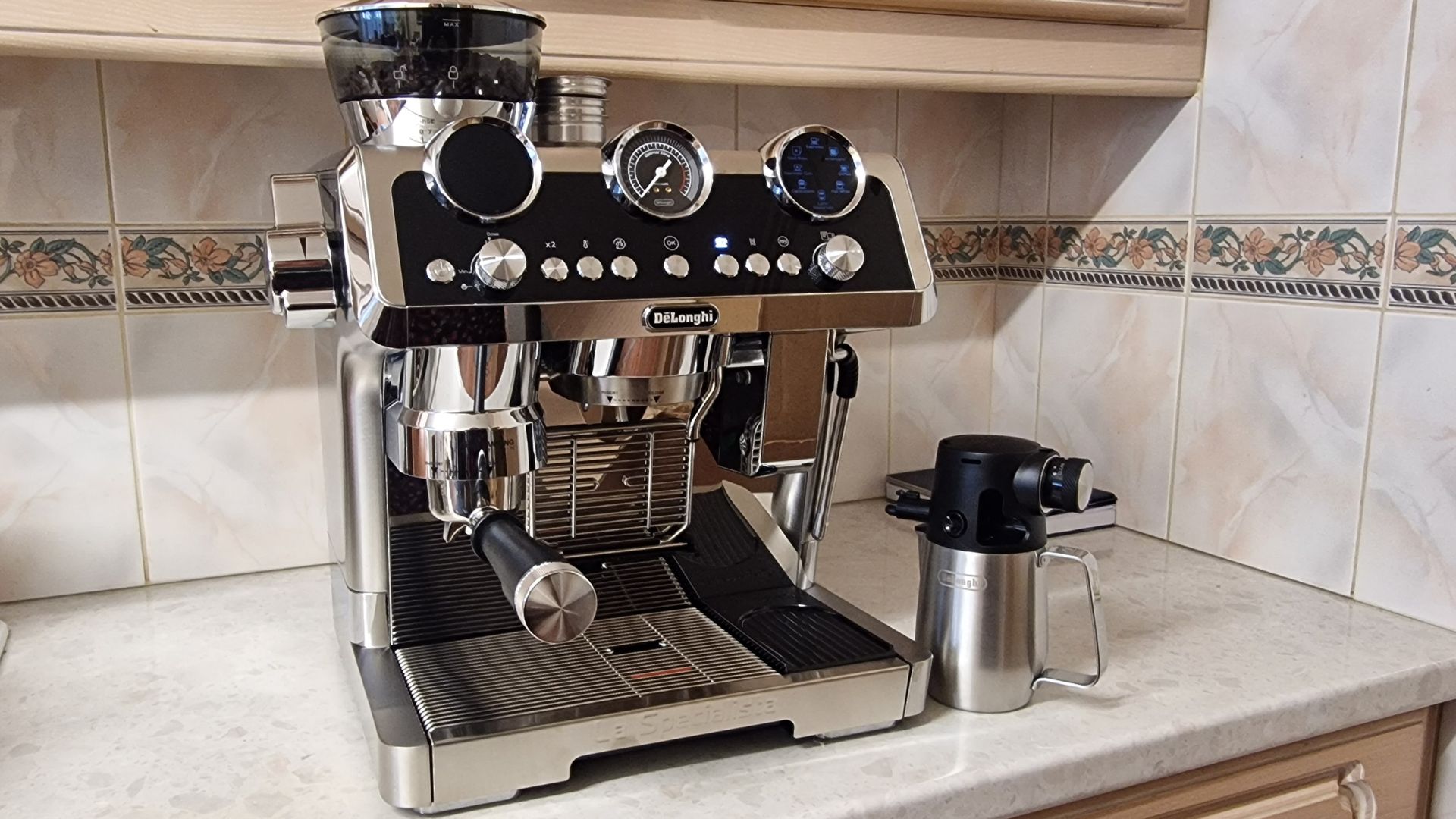
Be under no illusions: this machine is absolutely immense. It didn't fit under my kitchen cabinets. At a hefty 35lb and standing 17.5" tall, the De'Longhi La Specialista Maestro won't work in small kitchens. It looks lovely though, and the finish feels as luxe as it looks.
Due to the sheer size of the De'Longhi La Specialista Maestro, unboxing was a two-man job. Once out of the box though, it was easy enough to set up. You get two single and two double filters to use with the machine — a set that's designed to work with cold shots, and a set to work with regular espresso.
As De'Longhi's flagship espresso machine, the La Specialista Maestro has all the bells and whistles. It has the charm of a manual machine, but every step is automated, making it a true hybrid. This means you get a lot of buttons and three displays, two of which are smart-enabled to allow you to adjust grind size or select your desired coffee drink when brewing and steaming milk.
De'Longhi La Specialista Maestro review: Performance
Grinding
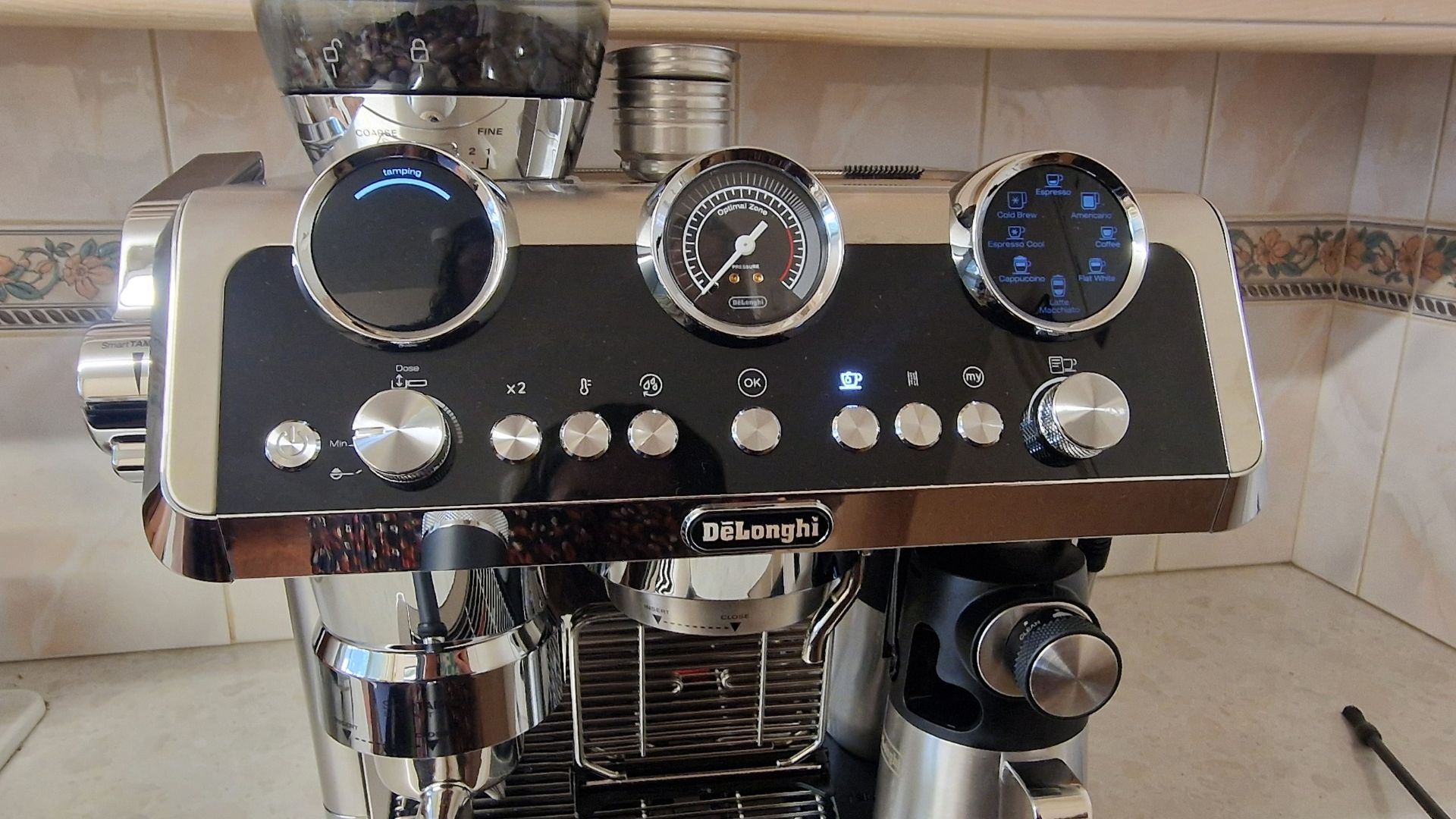
There are eight grind-size settings included with the De'Longhi La Specialista Maestro. I stuck to the finer settings for making espresso as I found that my extraction didn't hit the pressure I was looking for when I opted for the mid-larger sizes.
Grinding begins when you twist your empty portafilter into place, triggering the pre-set grind volume (depending on what size filter you're using) which will stop automatically. Instead of taking this out and tamping on your counter, which is a surefire way to get coffee grounds everywhere, you can then pull the left-hand tamping arm towards you to press your puck without any mess whatsoever.
These automated features do make it very hard to make tiny manual adjustments. When I found my finished puck to be a bit too shallow for example, it was a bit of a faff to add extra grounds to my filter. I also found that tamping two or three times was best to ensure that there was no loose coffee sitting on the top of my puck.
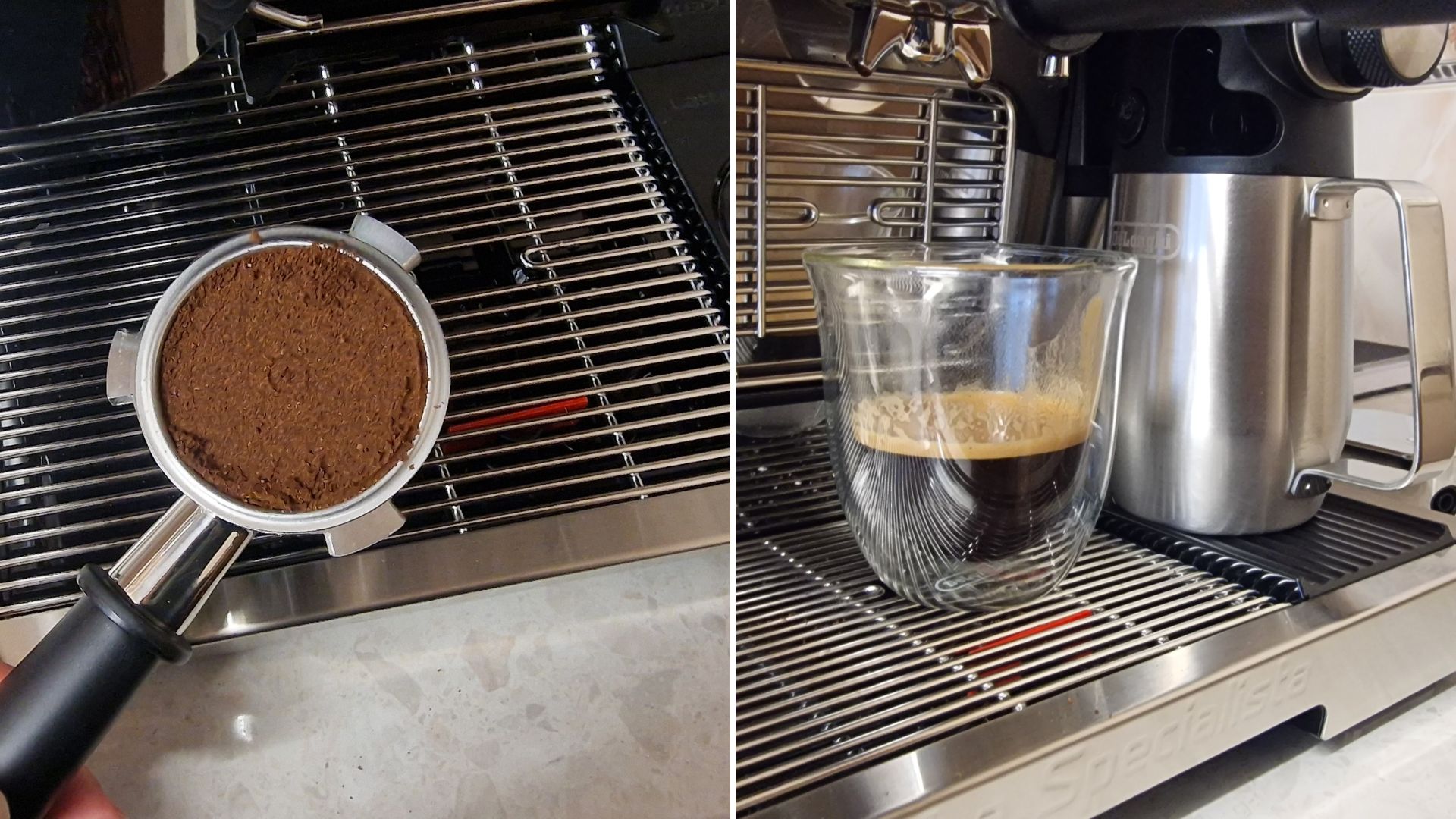
Brewing espresso
The De'Longhi La Specialista Maestro comes with 51mm portafilters instead of the more industry-standard 58mm width. In practice, you won't notice much of a difference compared to your usual brew unless your palette is much more refined than mine, but coffee fanatics would likely tell you that a wider and shallower portafilter would lead to a better extraction.
Once you've tamped, you need to select your desired drink on the right-most dial and then twist your portafilter into place. It's a small gripe, but I occasionally would stick my pristine puck into the water dispenser when attempting to slot it into the brewing unit, which would create a bit of mess, so precision is needed.
What are the drink options, you ask? The extensive list is as follows:
- Long Black
- Coffee
- Espresso
- Cold Brew
- Espresso Cool
- Cappuccino
- Flat White
- Latte Macchiato
- Hot Water
As with all bean-to-cup coffee makers, it took some fiddling with grind size and volume to reach a perfect extraction. Despite all the automated processes, the pressure gauge is authentically retro and very useful. It indicates an optimal pressure range, allowing you to make adjustments to your next brew if your coffee is over or under-extracted. Once I'd got to grips with the De'Longhi La Specialista Maestro it readily pumped out espresso after espresso with a thick, foamy crema and a well-balanced flavor profile.
Milk steaming
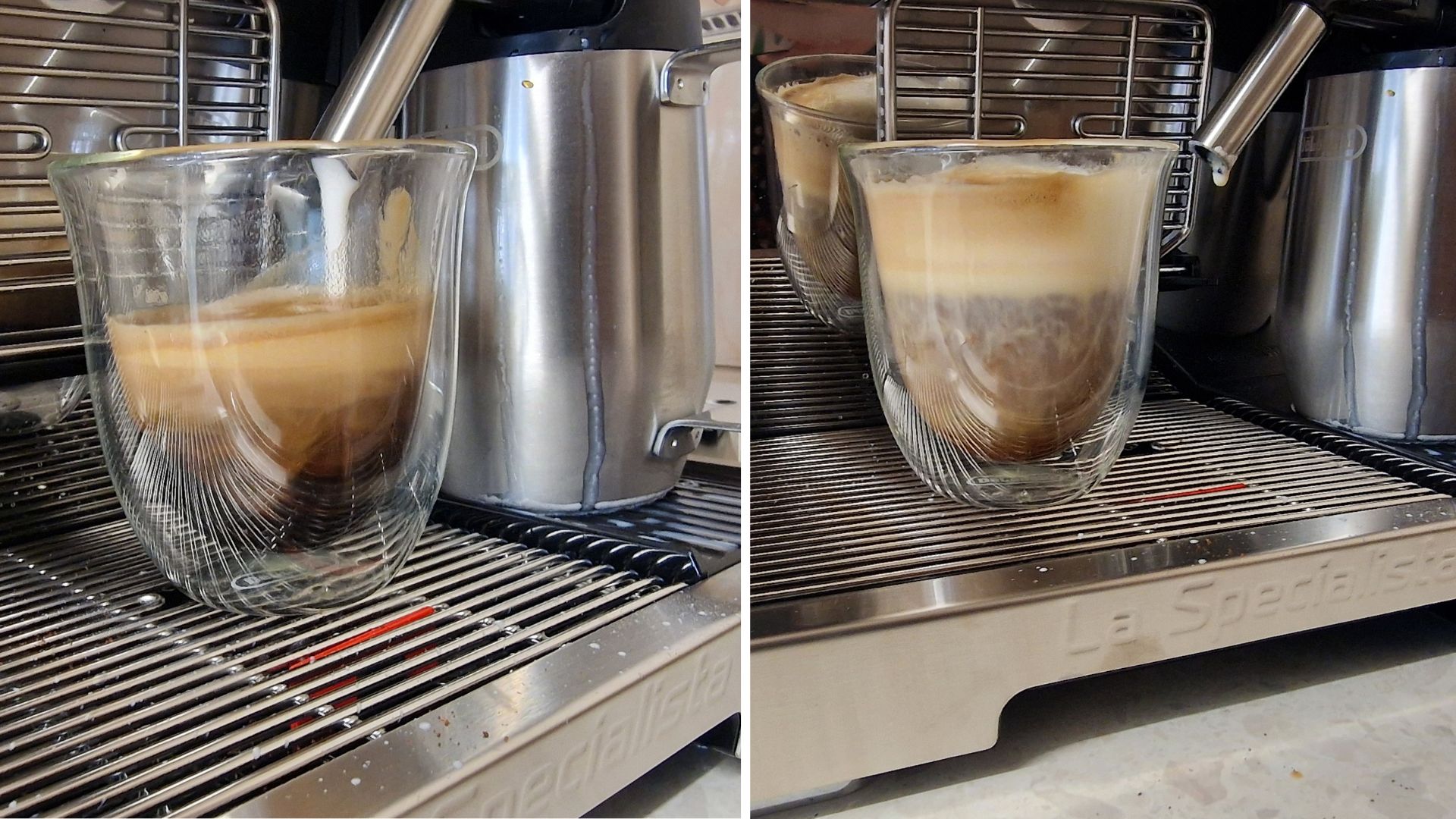
You get two milk steaming options with this machine, which is a nice touch. The first is a traditional manual steam wand which is punchy and powerful. It took a bit of getting used to, partly because De'Longhi's supplied milk jug is larger than the one I'm used to working with, and partly because I'm left-handed. The bias towards right-handed people in steam wand designs is by no means exclusive to this machine, but I have tried wands that were more flexible and allowed me to get a good micro-foam even as a left-handed person.
The automatic milk dispenser is akin to many alternatives you can buy from Cuisinart, Nespresso, etc. You attach a milk container to your machine and it pumps this through a tube and texturizes it as it dispenses into your mug. The De'Longhi La Specialista Maestro comes with a lid that clips onto the top of your milk jug that can then be slotted into the right-hand panel of your machine. You get three froth settings to choose from on the front dial, and there is also a setting for cleaning, which keeps the dispenser from clogging up with stale milk.
There's nothing wrong with this method, but as a coffee enthusiast I find that it just lacks the charm of hand-steamed milk. I found myself gravitating towards it when I was short on time, but my partner who couldn't care less about latte art exclusively used the automatic dispenser, which shows that this is a versatile machine which will suit just about any household.
Cold brew
Onto my main question when I took this coffee maker for a spin: does the cold brew setting really work? Cold brew, for the uninitiated, is the process of slowly steeping your coffee grounds in cold water, often overnight, to create a cold coffee concentrate that can be diluted with milk or water. It's not simply a cold espresso, because the flavor profile of your espresso is developed by extracting at high temperatures and pressure, so I often associate cold brew with an iced tea. It allows the flavor of your coffee to shine through, and is often more complex than espresso-based drinks.
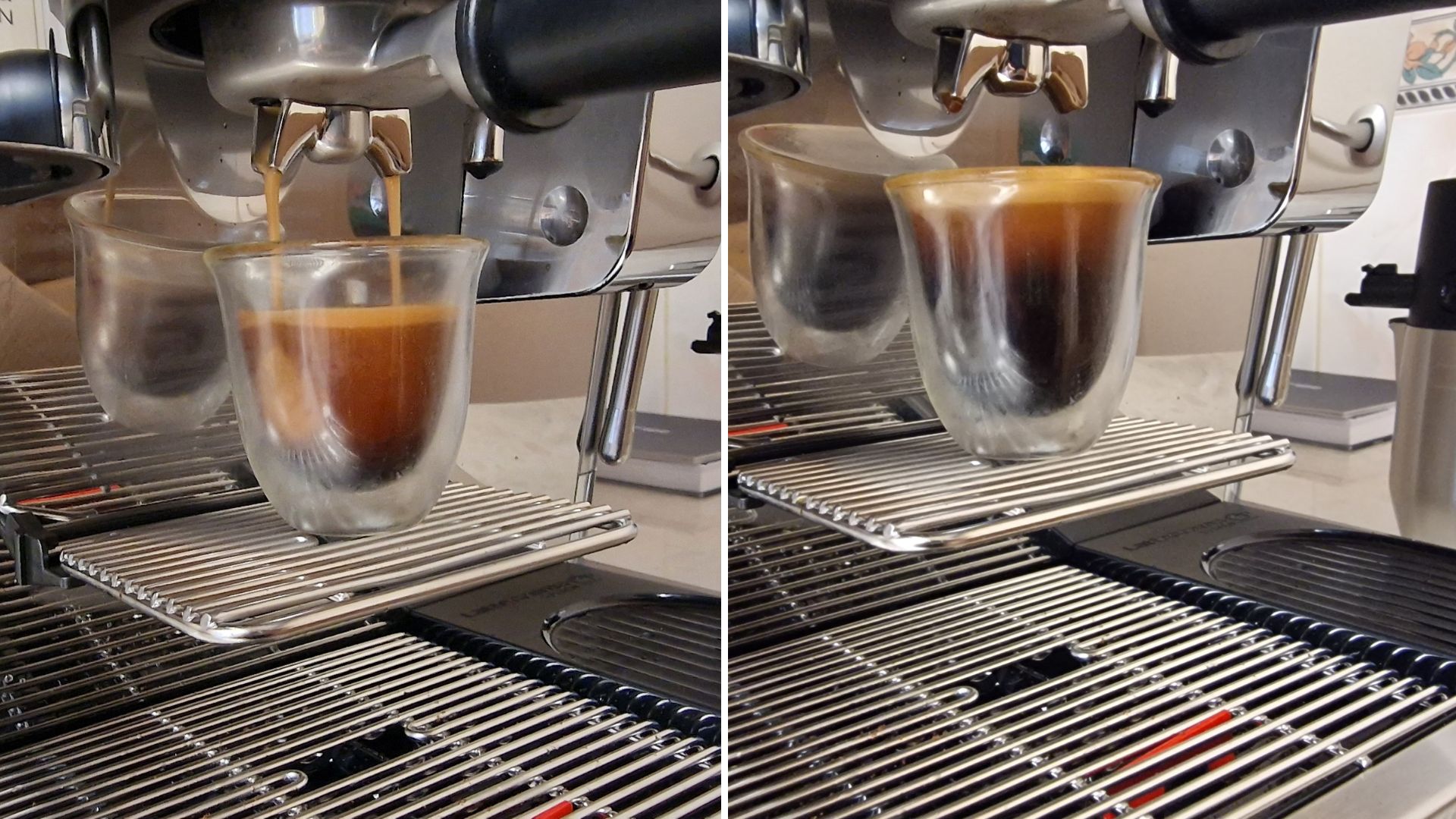
So, can you make cold brew in an espresso machine? De'Longhi's Cold Extraction Technology uses a dedicated water circuit that takes your room-temperature water and exerts just enough pressure to infuse your coffee and extract it without heating it or forcing the water through at high speeds, meaning the cold brew slowly drips into your cup and you're left with more of a sludge in your portafilter than a solid puck. The process takes up to five minutes depending on your chosen mode and grind settings, but most of the drinks I made were done in under two minutes.
I'm not sure if the cold settings on the De'Longhi make a true cold brew in the traditional sense, but I was astonished at how closely the taste resembled a cold brew. Consider me impressed.
How does the De'Longhi La Specialista Maestro compare?
The De'Longhi La Specialista Maestro is De'Longhi's flagship manual machine, but its handy automated functions make it more of a hybrid espresso machine, which is an emerging category of coffee maker that I'm particularly keen on. These machines look great, give you the classic feel of a barista, and allow you to independently control every element of your brew. I've yet to test it, but De'Longhi's La Specialista Arte Evo is akin to the Maestro but a bit less sophisticated. It's also smaller and cheaper, and it still comes with the cold brew settings.
The Maestro also bears some similarities to the machine I've been using for the past year at home, which is the Sage / Breville Barista Touch Impress. The Impress is roughly the same price as the Maestro, and it also has some mess-saving in-built tamping tech, although the Breville's is a little more slick. Unlike De'Longhi, Breville has a sensor that tells you if you need more grounds for an optimal extraction, and there's a handy button that lets you add this without having to re-start the whole grinding process. It also has a smart steam wand that automatically adjust the desired temperature and texture depending on your drink and milk type.
Should you buy the De'Longhi La Specialista Maestro
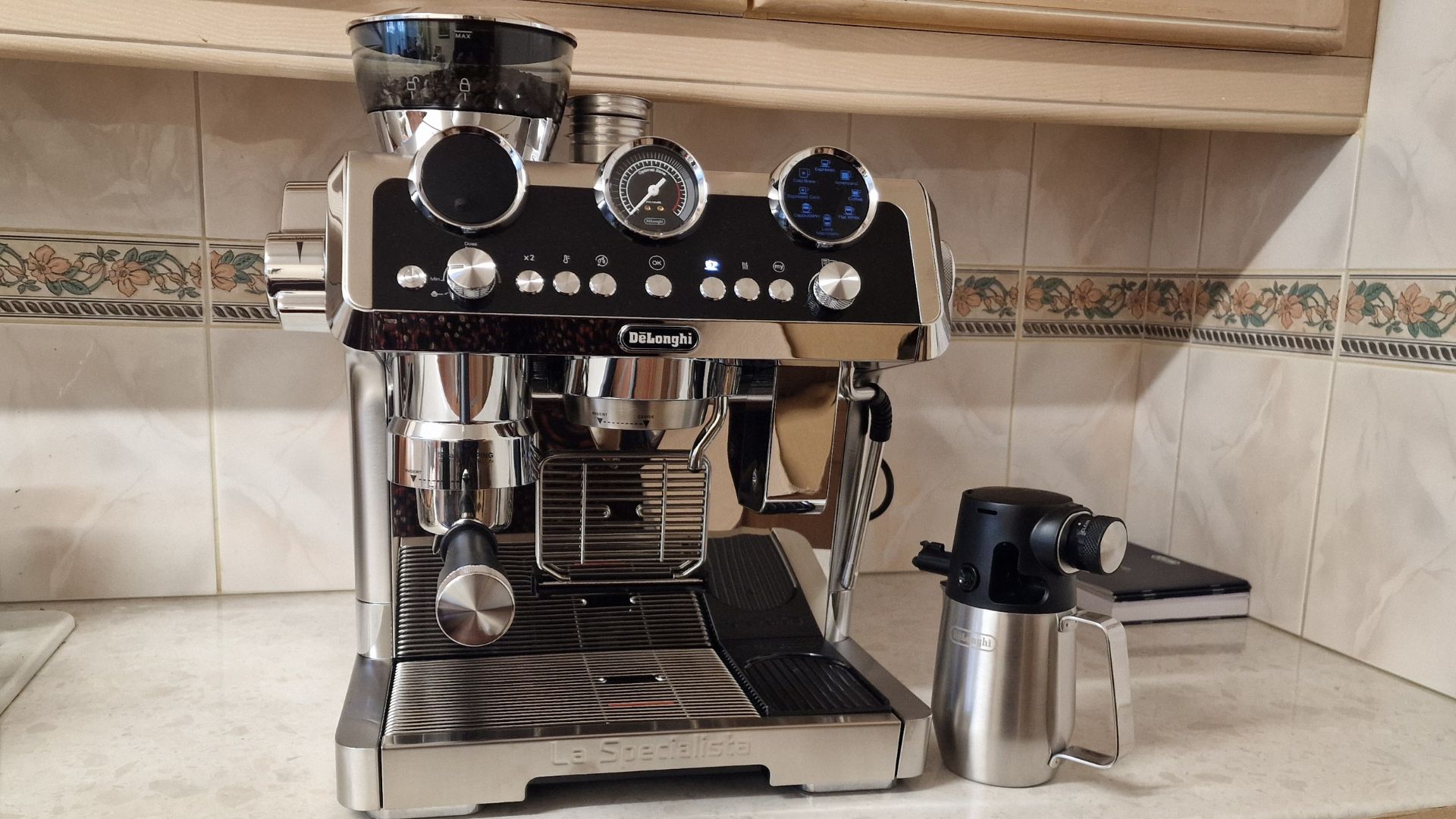
The De'Longhi La Specialista Maestro is not for the faint of heart. Large, hefty, and with a souped-up set of features, I think it's the perfect choice for a budding coffee-lover who wants a more capable appliance without sacrificing the look of a traditional espresso machine.
There are a few parts of the De'Longhi La Specialista Maestro that could feel a bit more plush and seamless. Although smart, the grinding could feel a bit fiddly if you didn't get the right ground volume the first time around. And while it's nice to have the option of both automatic and manual steaming, the manual wand isn't awesome for left-handed users, and the the automatic dispenser resembles the sort of thing that comes with many of the cheaper bean-to-cup coffee makers I've tried.
What really sets this coffee maker apart is its huge range of drink settings, and I was both impressed and surprised at how outstanding the cold brew tasted. If, like me, you're partial to an iced coffee or a cold brew as the weather picks up, this machine will make a great investment







